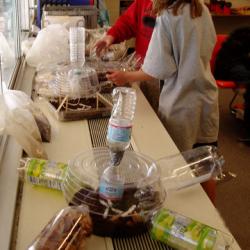Source Institutions
Add to list Go to activity
Activity link broken? See if it's at the internet archive

In this design-based activity, learners explore environments, ecosystems, energy flow and organism interactions by creating a model biodome. Learners become engineers who create model ecosystems. Learners design and create their own biodomes and watch what happens to the living and nonliving things they place in them.
- Under 5 minutes
- 4 to 24 hours
- $10 - $20 per group of students
- Ages 11 - 14
- Activity, Experiment/Lab Activity, Lesson/Lesson Plan, Model
- English
Quick Guide
Materials List (per group of students)
- Biodome Engineering Design Project Workbook
- 2 plastic containers (1- and 2-liter bottles with lids work well, or other inexpensive clear plastic trays/bowls with covers/lids)
- Seeds (provide several types for different climates)
- Soil (3-4 cups or .7-.9 l)
- Sand (3-4 cups or .7-.9 l)
- Supply of miscellaneous materials, such as pebbles, rocks, wire, small paper cups, plastic wrap, string, foil, popsicle sticks, chopsticks, etc.
- If insects or other animals are not available outside (due to the weather or other limitations), consider purchasing a small supply of worms or other organism from a pet store.
- Masking tape
- Duct tape
- Glue (preferred: hot glue sticks with glue guns)
- Scissors
- Exacto knives (if teacher cuts the plastic bottles)
- Butterfly nets and/or jars and paper cups (to catch and hold insects and worms)
- Drill (to make a hole in plastic bottle lids)
- Water
Subjects
-
Earth and Space Science
-
Solar System
- The Sun
-
Solar System
-
Engineering and Technology
-
Engineering
- Environmental Engineering
-
Engineering
-
Life Sciences
-
Diversity of Life
- Plants
- Animals
- Classification
-
Ecology
- Ecosystems
- Energy Flow and Chemical Cycles
-
Diversity of Life
-
Physical Sciences
-
Heat and Thermodynamics
- Heat and Temperature
- Heat Transfer
-
Chemistry
- Chemistry of Life
-
Heat and Thermodynamics
-
The Nature of Science
-
The Scientific Process
- Conducting Investigations
- Gathering Data
- Formulating Explanations
- Communicating Results
-
The Scientific Process
-
The Nature of Technology
-
The Design Process
- Research and Development
- Invention and Innovation
- Problem Solving
- Troubleshooting and Maintenance
-
The Design Process
Informal Categories
- Animals
- Model Building
- Nature and Environment
- Outdoor Activity
Audience
To use this activity, learners need to:
- see
- read
- be mobile
- touch
Learning styles supported:
- Involves teamwork and communication skills
- Involves hands-on or lab activities
Other
Includes alignment to state and/or national standards:
Includes assesments for student learning:
This resource is part of:
Access Rights:
- Free access
By:
- Beggs, Katherine ; Valenti, Christopher ; Schaefer Zarske, Malinda ; Carlson, Denise
Source Collection
- TeachEngineering
Rights:
- All rights reserved, Regents of the University of Colorado, 2004
Funding Sources:
- Fund for the Improvement of Postsecondary Education (FIPSE)
- U.S. Department of Education
- National Science Foundation GK-12, 0338326
